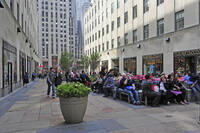| dc.coverage.spatial | Site: New York, New York, United States | en_US |
| dc.coverage.temporal | ca. 1934-1936 (creation) | en_US |
| dc.creator | Manship, Paul | en_US |
| dc.creator | Chambellan, Rene Paul | en_US |
| dc.creator | Hood, Raymond M. | en_US |
| dc.date | 1934-1936 | en_US |
| dc.date.accessioned | 2013-12-05T16:03:50Z | |
| dc.date.available | 2013-12-05T16:03:50Z | |
| dc.date.issued | 1934-1936 | en_US |
| dc.identifier | 241324 | en_US |
| dc.identifier.other | archrefid: 2946 | en_US |
| dc.identifier.uri | http://hdl.handle.net/1721.3/149564 | |
| dc.description | Promenade; 30 Rockefeller Plaza in the center background; The Channel Gardens separates La Maison Française (610 Fifth Avenue) from the British Empire Building (620 Fifth Avenue), just as the English Channel separates the two countries. The gardens are built on a gentle slope leading to the Sunken Plaza. There are 6 pools with fountainhead sculptures. The tritons, nereids, and other bronze creatures in the garden fountains are the work of sculptor René Chambellan. The design for each of them was personally approved by John D. Rockefeller, Jr. The Sunken Plaza was planned primarily to lure customers down to the center's extensive underground concourses. It was equipped with a winter ice skating rink for the first time in 1936. It contains the Manship statues "Mankind (Maiden and Youth)" flanking the entrance and the gold gilded "Prometheus" in the plaza fountain. The Promenade between the Plaza and 30 Rockefeller Center was originally planned as a through street, but a building owner on West 52nd St. blocked that plan and eventually it was closed to traffic. Source: Rockefeller Center [website]; http://www.rockefellercenter.com/ (accessed 8/10/2013) | en_US |
| dc.format.medium | bronze; paving; plant materials; gold leaf | en_US |
| dc.rights | © Scott Gilchrist, Archivision, Inc. | en_US |
| dc.subject | allegory | en_US |
| dc.subject | botanical | en_US |
| dc.subject | cityscape | en_US |
| dc.subject | mythology (Classical) | en_US |
| dc.subject | City planning | en_US |
| dc.subject | Fountains | en_US |
| dc.subject | Gardens | en_US |
| dc.subject | Twentieth century | en_US |
| dc.subject | Art Deco | en_US |
| dc.title | Rockefeller Center; Channel Gardens, Promenade and Plaza | en_US |
| dc.title.alternative | Channel Gardens, Promenade and Plaza | en_US |
| dc.type | image | en_US |
| dc.rights.access | Licensed for educational and research use by the MIT community only | en_US |
| dc.identifier.vendorcode | 1A1-RH-RC-S04 | en_US |
| vra.culturalContext | American | en_US |
| vra.technique | gardening, casting (process) | en_US |
| vra.worktype | promenade (walkway) | en_US |
| vra.worktype | sculpture (visual work) | en_US |
| vra.worktype | fountain | en_US |
| vra.worktype | garden | en_US |
| dc.contributor.display | Paul Manship (American sculptor, 1885-1966); Raymond M. Hood (American architect, 1881-1934); Rene Paul Chambellan (American sculptor, 1893-1955) | en_US |


